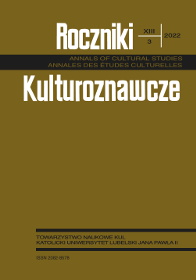The Customs of Siberian Koryaks. The Use of Fly Agaric (Amanita Muscaria) in Kamchatka Folk Medicine
Abstract
This article refers to use of the red fly agarics (Amanita muscaria) by the siberian Koryak people living in the Kamchatka Peninsula. Linguistic and archeological evidence indicates a very early use of toadstools in Siberia. Presence of Amanita muscaria in myths and its direct link to Koryak supreme deity proves that those mushrooms had in the past important function in the local shamanism. Their presence in folk medicine has also been observed today. Despite the still alive beliefs associated with red toadstools, their consumption is nowadays difficult to consider as ritual behavior in the strict sense. It seems that the abandonment of toadstool consumption is one of the signals of a much larger phenomenon, which is the loss of old shamanistic Koryak traditions, beliefs and practices.
Through a possible reconstruction of the former meaning that Amanita muscaria had among Koryaks and by looking at modern opinion on these mushrooms, an attempt was made to capture and compare the past and present role of toadstools in this community. The collected materials suggest that the significance of their use is not as important today as it used to be – however, there are people who still use these mushrooms. The available literature does not allow for a detailed presentation of the contemporary conceptualization of Koryak use of the red fly agarics based on the examination of the specific cases of intoxication. This is an issue that requiers further research and can be explored by collecting interviews and recording changes and constans in the behavior and beliefs of the Siberian people.
References
Alberts Andreas i Peter Mullen. Psychoaktywne rośliny i grzyby. Tłum. Małgorzata Świdzińska. Warszawa: MUZA SA, 2002.
Bader, Jacek H. Biała gorączka. Wołowiec: Wydawnictwo Czarne, 2019.
Beniowski, Maurycy A. Dziennik podróży i zdarzeń hrabiego M. A. Beniowskiego na Syberyi, w Azyi i Afryce, cz. 2. Kraków: staraniem S. Szczepanowskiego i A. Potockiego, 1898.
Breeze Wood, Nicholas. „Kutchaʼs Children. The Koryak People of Kamchatka”, Sacred Hoop. The Shamanism Magazine 2010: 20-24. http://www.sacredhoop.org/Articles/KUTCHAS-CHILDREN.pdf (dostęp: 31.03.2022).
Charrin, Anne-Victoire. „The Discovery of the Koryaks and Their Perception of the World”, Arctic 37, nr 4 (1984): 441-445; https://journalhosting.ucalgary.ca/index.php/arctic/article/view/65278/49192 (dostęp: 31. 03. 2022).
Cooke, Mordecai Cubitt. The Seven Sisters of Sleep. London: James Blackwood, Paternoster Row, 1860.
Czaplicka, Maria. Shamanism in Siberia. Aboriginal Siberia, A Study in Social Anthropology, London: Forgotten Books, 2007.
Dąbrowski, Grzegorz. Rytuały przejścia a użycie substancji psychoaktywnych. Wrocław: Wydawnictwo Katedry Etnologii i Antropologii Kulturowej Uniwersytetu Wrocławskiego, 2006.
Dunn, Ethel. „Russian Use of Amanita Muscaria: A Footnote to Wassonʼs Soma”. Current Anthropology 14, nr 4 (1973): 488-492. https://www.journals.uchicago.edu/doi/pdf/10.1086/201365 (dostęp: 01. 04. 2022).
Eliade, Mircea. Szamanizm i archaiczne techniki ekstazy. Tłum. Krzysztof Kocjan. Warszawa: Wydawnictwo Naukowe PWN, 1994.
Furst, Peter T. Hallucinogens and Culture. Novato: Chandler & Sharp Publishers, 1976.
Harner, Michael. Droga szamana. Tłum. Dagmara Chojnacka. Wrocław: Wydawnictwo Dolnośląskie, 2007.
Furst, Peter T. „Visionary Plants and Ecstatic Shamanism”, Expedition 46, nr 1 (2004): 26-29.
Jochelson, Waldemar. The Koryak. W: The Jesup North Pacific Expedition. Memoir of the American Museum of Natural History, t. VI, E. J. Brill, Leiden, i G. E. Stechert, New York 1908.
Kalinowski, Daniel G. Cztery Szlachetne Prawdy. Motywy buddyjskie w literaturze polskiej do czasów pozytywizmu. Kraków: Księgarnia Akademicka, 2021.
Khakhovskaya, Lyudmila N. „Alcohol Consumption Practices in the Koryak Community”, Journal of Ethnology and Folkloristics 10, nr 2 (2016): 47-63. https://content.sciendo.com/view/journals/jef/10/2/article-p47.xml (dostęp: 01.04.2022).
King, Alexander D. Living with Koryak Traditions. Playing with Culture in Siberia, Lincoln & London: University of Nebraska Press, 2011.
King, Alexander D. „Reindeer Herdersʼ Culturescapes in the Koryak Autonomous Okrug”. W: People and the Land. Pathways to Reform in Post-Soviet Siberia, 63-80. Berlin: Dietrich Reimer Verlag, 2002, https://dh-north.org/siberian_studies/publications/plking.pdf (dostęp: 31.03.2022).
Michelot Didier i Leda Maria Melendez-Howell. Amanita muscaria: Chemistry, biology, toxicology, and ethnomycology, Mycological Research 107, nr 2 (2003): 131-146, https://www.naturamediterraneo.com/Public/data3/alessio/MYR_MICHELOT_2003.pdf_200661215235_MYR_MICHELOT_2003.pdf (dostęp: 01.04.2022).
Minahan, James B. „Koryak”. W: Ethnic Groups of North, East, and Central Asia: An Encyclopedia, 149-152. Santa Barbara: ABC-CLIO, 2014.
Nowik, Elena. Szamanizm syberyjski. Obrzęd i folklor. Próba porównania struktur. Kraków: Zakład Wydawniczy NOMOS, 1993.
Nyberg, Harri. „Religious use of hallucinogenic fungi: A comparison between Siberian and Mesoamerican cultures”. Karstenia. The Journal of Finnish Mycological Society 32 (1992): 71-80, https://www.samorini.it/doc1/alt_aut/lr/nyberg-religious-use-of-hallucinogenic-fungi.pdf (dostęp: 01.04.2022).
Ott, Jonathan. Pharmacotheon. Entheogenic drugs, their plant sources and history. Kennewick: Natural Products Co., 1996.
Paluch, Adam. Zerwij ziele z dziewięciu miedz. Ziołolecznictwo ludowe w Polsce w XIX i początku XX wieku. Wrocław: Polskie Towarzystwo Ludoznawcze, 1989.
Pinchbeck Daniel i Sophia Rokhlin. Gdy rośliny śnią: ayahuasca, amazoński szamanizm i ogólnoświatowy renesans psychodeliczny. Tłum. Maciej Lorenz. Warszawa: Wydawnictwo Cień Kształtu, 2020.
Rudgley, Richard. Alchemia kultury. Od opium do kawy. Tłum. Ewa Klekot. Warszawa: Państwowy Instytut Wydawniczy, 2002.
Schultes, Richard E. Hallucinogenic Plants: A Golden Guide. New York: Golden Press. Western Publishing, 1976.
Wargacki, Stanisław A. „Mistyczne – Odmienne Stany Świadomości – Neuroteologia”. Nomos 57/58 (2007): 23-39.
Zięborak, Mateusz. „Rola muchomora czerwonego w kulturach plemiennych dawnej Syberii”. Wrocław: Uniwersytet Wrocławski, 2006, http://www.taraka.pl/rola_muchomora (dostęp: 01.04.2022).





